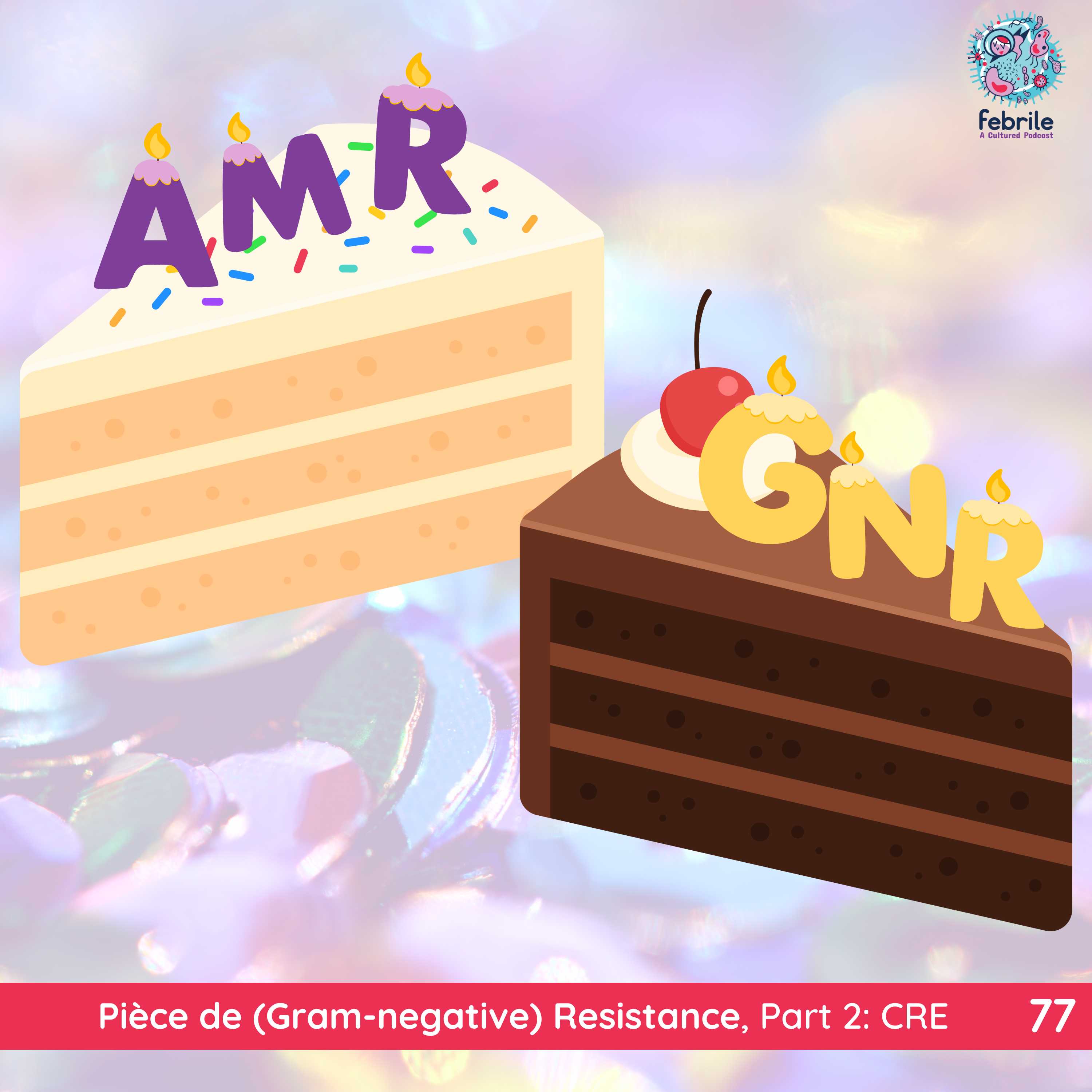Table of Contents
Credits
Host(s): Hawra Al-Lawati, Sara Dong
Guest: Pranita Tamma
Writing: Hawra Al-Lawati, Sara Dong
Producing/Editing/Cover Art: Sara Dong
Infographics: Hawra Al-Lawati
Our Guests
Guest Co-Host
Hawra Al-Lawati, MD

Hawra Al-Lawati is a recently graduated adult ID fellow from Beth Israel Deaconess Medical Center in Boston, MA. She is interested in medical education and antimicrobial stewardship. You can find some of her infographic work with prior Febrile episodes #3 (A Transplant Tale) and #6 (The Fever & The Worm).
Guest Discussant
Pranita Tamma, MD, MPH

Pranita Tamma is an Associate Professor of Pediatrics in the Division of Infectious Diseases and Director of the Pediatric Antimicrobial Stewardship Program at Johns Hopkins University. She received her MD from SUNY Downstate Medical Center and then completed pediatric residency and pediatric infectious diseases fellowship training at Johns Hopkins.
Consult Notes
Key Points
The newest update of the IDSA Guidance on the Treatment of Antimicrobial Resistant (AMR) Gram-negative Infections
was released the same month of this episode release! https://www.idsociety.org/practice-guideline/amr-guidance/
This episode focused on carbapenem-resistant Enterobacterales (CRE) infections. You can check out a summary of the cases below
17 year old M presenting with fevers, hydronephrosis & blood cultures are preliminarily growing GNRs. Prelim susceptibilities via Kirby-Bauer indicated ceftriaxone resistance. The resident had listened to the first part of this series and remembered that the recommended treatment was carbapenems and the patient was started placed on meropenem. 24 hours later the patient feels slightly better but still febrile. Blood cultures are finalized as Klebsiella pneumoniae. The primary team calls for help because “there are a lot of Rs on the susceptibility report”:
KLEBSIELLA PNEUMONIAE | MIC | Interpretation |
Amikacin | 6 | S |
Ampicillin/sulbactam | 2 | R |
Cefazolin | 4 | R |
Cefepime | 4 | R |
Ceftazidime | 4 | R |
Ceftriaxone | 4 | R |
Ciprofloxacin | 4 | R |
Gentamicin | 6 | R |
Meropenem | 4 | R |
Piperacillin/tazobactam | 8 | R |
Tobramycin | 6 | R |
Trimethoprim/Sulfa | 6 | R |
KLEBSIELLA PNEUMONIA. Carbapenemase (IMP, VIM, NDM, KPC, and OXA-48) target DNA sequences not detected. Isolate is carbapenem nonsusceptible due to other mechanisms. Test performed by GeneXpert real-time PCR. |
Additional results from extended susceptibility testing are noted below:
KLEBSIELLA PNEUMONIAE | MIC | Interpretation |
Amikacin | 6 | S |
Ampicillin/sulbactam | 2 | R |
Aztreonam | R | |
Cefazolin | 4 | R |
Cefepime | 4 | R |
Ceftazidime | 4 | R |
Ceftazidime/avibactam | 2 | S |
Ceftolozane/tazobactam | >256 | R |
Ceftriaxone | 4 | R |
Ciprofloxacin | 4 | R |
Gentamicin | =>16 | R |
Imipenem/relebactam | 0.5 | S |
Meropenem | 4 | R |
Meropenem/vaborbactam | 4 | S |
Minocycline | R | |
Piperacillin/tazobactam | >128 | R |
Tetracycline | R | |
Tigecycline | 4 | I |
Tobramycin | >=16 | R |
Trimethoprim/Sulfa | >=16 | R |
78 y/o F presents hx of recurrent UTIs admitted with altered mental status found to have pyelonephritis. Urine cultures are growing gram negatives. She was started on cefepime empirically. 24 hours later the urine cultures come back with meropenem resistant Enterobacter.
ENTEROBACTER CLOACAE COMPLEX | MIC | Interpretation |
Amikacin | 4 | S |
Aztreonam | R | |
Cefepime | >=64 | R |
Ceftriaxone | >=64 | R |
Ciprofloxacin | >=4 | R |
Gentamicin | >=16 | R |
Meropenem | >=16 | R |
Nitrofurantoin | 32 | S |
Omadacycline | 8 | |
Piperacillin/tazobactam | >=128 | R |
Tetracycline | R | |
Tobramycin | >=16 | R |
Trimethoprim/Sulfa | >=16 | R |
Carbapenemase target DNA sequences detected. Test performed by GeneXpert real-time PCR. |
IMP target DNA sequence: Not detected |
VIM target DNA sequence: Not detected |
NDM target DNA sequence: Detected |
KPC target DNA sequence: Not detected |
OXA-48 target DNA sequence: Not detected |
CRE Basics
CRE is defined by the CDC as members of Enterobacterales resistant to at least one carbapenem antibiotic or producing a carbapenemase enzyme
- You can find the CDC CRE Control and Prevention page here
- Remember that CRE is a heterogenous group of organisms that can have multiple mechanisms of resistance → this is usually divided into:
- Carbapenemase-producing (CP-CRE), or
- Non-carbapenemase-producing (non-CP-CRE)
- Carbapenemase-producing isolates account for about 35-60% of CRE cases in the US when the CDC definition is used – while non-CP-CRE are often the result of amplification of non-carbapenemase beta-lactamase genes (such as ESBL genes) with concurrent outer membrane porin disruptions
- van Duin D, Arias CA, Komarow L, et al. Molecular and clinical epidemiology of carbapenem-resistant Enterobacterales in the USA (CRACKLE-2): a prospective cohort study [published correction appears in Lancet Infect Dis. 2020 Apr 23;:]. Lancet Infect Dis. 2020;20(6):731-741. doi:10.1016/S1473-3099(19)30755-8
- Sabour S, Huang JY, Bhatnagar A, et al. Detection and Characterization of Targeted Carbapenem-Resistant Health Care-Associated Threats: Findings from the Antibiotic Resistance Laboratory Network, 2017 to 2019. Antimicrob Agents Chemother. 2021;65(12):e0110521. doi:10.1128/AAC.01105-21
- The most common carbapenemases in the US = K.pneumoniae carbapenemases (KPCs)
- This is NOT limited to just K.pneumoniae isolates
- Other notable carbapenemases include:
- New Delhi metallo-β-lactamases (NDMs)
- Verona integron-encoded metallo-β-lactamases (VIMs)
- Imipenem-hydrolyzing metallo-β-lactamases (IMPs)
- Oxacillinases like OXA-48-like
- Knowing which carbapenemase is present can help guide therapy, almost like precision medicine, as Pranita noted in the episode
Treatment of CRE infections when carbapenemase testing results are either not available or negative
- The preferred treatment approach for infections caused by CRE isolates outside of the urinary tract include:
- Ceftazidime-avibactam
- Meropenem-vaborbactam
- Imipenem-cilastatin-relebactam
- Alternatives include:
- Full treatment course with aminoglycoside for CRE pyelonephritis or complicated UTI
- If the case is treatment of uncomplicated cystitis, the preferred options if available include the following (the likelihood of susceptibility to these agents is low):
- Nitrofurantoin
- TMP-SMX
- Ciprofloxacin or levofloxacin
- Alternatives include:
- Single dose of aminoglycoside
- Oral fosfomycin (for E.coli only)
- Colistin
- Usually preserved for more invasive infections: Ceftazidime-avibactam, meropenem-vaborbactam, impenem-cilastatin-relebactam, cefiderocol
Treatment of CRE infections when carbapenemases are identified/present
- A quick summary of activity of the newer beta-lactam-beta-lactamase inhibitors or other novel agents:
- Ceftazidime-avibactam has activity against most KPC and OXA-48-like producing CRE isolates
- Meropenem-vaborbactam and imipenem-relebactam are against against most KPC but not those that produce OXA-48-like carbapenemases
- Neither ceftazidime-avibactam, meropenem-vaborbactam, nor imipenem-relebactam have activity against metallo-β-lactamases (like NDM)
- Cefiderocol retains activity against all carbapenemases
- Fortunately all of these drugs are generally active against non-CP-CRE
- When KPC production is present, the preferred agents include:
- Meropenem-vaborbactam
- Ceftazidime-avibactam
- Imipenem-cilastatin-relebactam
- Alternative: cefiderocol
- *We discussed that although all 3 agents are preferred, Pranita and the panel slightly favors the agents in the order listed based on available data on clinical outcomes and emergency of resistance*
- Although clinical head-to-head trials are not available, here is some available data:
- Ackley R, Roshdy D, Meredith J, et al. Meropenem-Vaborbactam versus Ceftazidime-Avibactam for Treatment of Carbapenem-Resistant Enterobacteriaceae Infections. Antimicrob Agents Chemother. 2020;64(5):e02313-19. Published 2020 Apr 21. doi:10.1128/AAC.02313-19
- Compared outcomes of 26 patients receiving meropenem-vaborbactam and 105 patients receiving ceftazidime-avibactam for CRE (carbapenemase status mostly unavailable). Clinical cure and 30-day mortality between meropenem-vaborbactam and ceftazidime-avibactam groups were 85% / 61% and 12% / 19%, respectively. Although not statistically significant, favored meropenem-vaborbactam.
- Also 0/3 (0%) in meropenem-vaborbactam vs 3/15 (20%) in ceftazidime-avibactam groups had subsequent CRE isolates in recurrent infection that developed resistance to initial therapy
- This slightly higher likelihood of clinical cure and survival with lower risk of resistance with meropenem-vaborbactam vs ceftazidime-avibactam has been noted in other clinical experiences as well:
- Shields RK, McCreary EK, Marini RV, et al. Early Experience With Meropenem-Vaborbactam for Treatment of Carbapenem-resistant Enterobacteriaceae Infections [published correction appears in Clin Infect Dis. 2020 Mar 3;70(6):1265]. Clin Infect Dis. 2020;71(3):667-671. doi:10.1093/cid/ciz1131
- Tumbarello M, Raffaelli F, Cascio A, et al. Compassionate use of meropenem/vaborbactam for infections caused by KPC-producing Klebsiella pneumoniae: a multicentre study. JAC Antimicrob Resist. 2022;4(1):dlac022. Published 2022 Mar 7. doi:10.1093/jacamr/dlac022
- Shields RK, Nguyen MH, Chen L, Press EG, Kreiswirth BN, Clancy CJ. Pneumonia and Renal Replacement Therapy Are Risk Factors for Ceftazidime-Avibactam Treatment Failures and Resistance among Patients with Carbapenem-Resistant Enterobacteriaceae Infections. Antimicrob Agents Chemother. 2018;62(5):e02497-17. Published 2018 Apr 26. doi:10.1128/AAC.02497-17
- Imipenem-relebactam was the newer of the 3 drugs, and there is less data for it compared to the other 2 probably for that reason
- Ultimately the choice amongst the 3 will likely be largely impacted by price/formulary availability locally as well as the nuances of patient factors (such as allergies, underlying medical conditions, etc)
- When NDM production is present:
- Ceftazidime-avibactam + Aztreonam combination therapy, or
- How/why does this work? NDMs hydrolyze penicillins, cephalosporins, and carbapenems – but not aztreonam! Aztreonam likes to target and bind PBP3, which it can do even in the presence of NDM. Unfortunately these CRE organisms often have co-production of other beta-lactamases (such as AmpC, ESBL, or KPC) which can hydrolyze aztreonam. Avibactam Is effective at inhibiting these other beta-lactamases, sort of “protecting” aztreonam so that it can work! The ceftazidime doesn’t do anything, it’s just there for the moment given the aztreonam-avibactam combination is not currently available as a drug on its own
- There is not currently a CLSI-approved way to test susceptibility of this combination, although there have been groups describing methods to test susceptibility
- As Pranita mentioned, there are some tips and strategies on administering this combination in Table 1 and the Supplemental Material in the Guidance
- Cefiderocol monotherapy
- As an FYI on mechanism of action: Cefiderocol is a conjugate composed of a cephalosporin and a sideophore (which binds to iron and facilitates cell entry using active iron transporters – why it is called the “trojan horse” sometimes) → once inside, the cephalosporin moiety can bind PBP3 to inhibit cell wall synthesis
- Some resources:
- Bassetti M, Echols R, Matsunaga Y, et al. Efficacy and safety of cefiderocol or best available therapy for the treatment of serious infections caused by carbapenem-resistant Gram-negative bacteria (CREDIBLE-CR): a randomised, open-label, multicentre, pathogen-focused, descriptive, phase 3 trial. Lancet Infect Dis. 2021;21(2):226-240. doi:10.1016/S1473-3099(20)30796-9
- Shaw E, Rombauts A, Tubau F, et al. Clinical outcomes after combination treatment with ceftazidime/avibactam and aztreonam for NDM-1/OXA-48/CTX-M-15-producing Klebsiella pneumoniae infection. J Antimicrob Chemother. 2018;73(4):1104-1106. doi:10.1093/jac/dkx496
- Biagi M, Wu T, Lee M, Patel S, Butler D, Wenzler E. Searching for the Optimal Treatment for Metallo- and Serine-β-Lactamase Producing Enterobacteriaceae: Aztreonam in Combination with Ceftazidime-avibactam or Meropenem-vaborbactam. Antimicrob Agents Chemother. 2019;63(12):e01426-19. doi:10.1128/AAC.01426-19
- Hobson CA, Bonacorsi S, Fahd M, et al. Successful Treatment of Bacteremia Due to NDM-1-Producing Morganella morganii with Aztreonam and Ceftazidime-Avibactam Combination in a Pediatric Patient with Hematologic Malignancy. Antimicrob Agents Chemother. 2019;63(2):e02463-18. Published 2019 Jan 29. doi:10.1128/AAC.02463-18
- Sieswerda E, van den Brand M, van den Berg RB, et al. Successful rescue treatment of sepsis due to a pandrug-resistant, NDM-producing Klebsiella pneumoniae using aztreonam powder for nebulizer solution as intravenous therapy in combination with ceftazidime/avibactam. J Antimicrob Chemother. 2020;75(3):773-775. doi:10.1093/jac/dkz495
- Benchetrit L, Mathy V, Armand-Lefevre L, Bouadma L, Timsit JF. Successful treatment of septic shock due to NDM-1-producing Klebsiella pneumoniae using ceftazidime/avibactam combined with aztreonam in solid organ transplant recipients: report of two cases. Int J Antimicrob Agents 2020; 55(1): 105842.
- Falcone M, Daikos GL, Tiseo G, et al. Efficacy of Ceftazidime-avibactam Plus Aztreonam in Patients With Bloodstream Infections Caused by Metallo-beta-lactamase-Producing Enterobacterales. Clin Infect Dis 2021; 72(11): 1871-8
- Timsit JF, Paul M, Shields RK, et al. Cefiderocol for the Treatment of Infections Due to Metallo-B-lactamase-Producing Pathogens in the CREDIBLE-CR and APEKS-NP Phase 3 Randomized Studies. Clin Infect Dis 2022; 75(6): 1081-4.
- Sempere A, Vinado B, Los-Arcos I, et al. Ceftazidime-Avibactam plus Aztreonam for the Treatment of Infections by VIM-Type-Producing Gram-Negative Bacteria. Antimicrob Agents Chemother 2022: e0075122.
- Sreenivasan P, Sharma B, Kaur S, et al. In-vitro susceptibility testing methods for the combination of ceftazidime-avibactam with aztreonam in metallobeta-lactamase producing organisms: Role of combination drugs in antibiotic resistance era. J Antibiot (Tokyo) 2022; 75(8): 454-62.
- Ceftazidime-avibactam + Aztreonam combination therapy, or
- When OXA-48-like production is present:
- Ceftazidime-avibactam
- Alternative: cefiderocol
Infographics
Goal
Listeners will be able to discuss management of serious carbapenem-resistant Enterobacterales (CRE) infections
Learning Objectives
After listening to this episode, listeners will be able to:
- Compare and contrast carbapenemase-producing and non-carbapenemase-producing Enterobacterales mechanisms
- Identify the most common carbapenemase in the US (KPC)
- Discuss treatment of CRE infections, including NDM-producing isolates
Disclosures
Our guest (Pranita Tamma) as well as Febrile podcast and hosts report no relevant financial disclosures
Citation
Tamma, P., Al-Lawati, H., Dong, S. “#77: Pièce de (Gram-negative) Resistance, Part 2: CRE”. Febrile: A Cultured Podcast. https://player.captivate.fm/episode/24e3629d-db56-4d8e-b3a1-df850280ca0a


